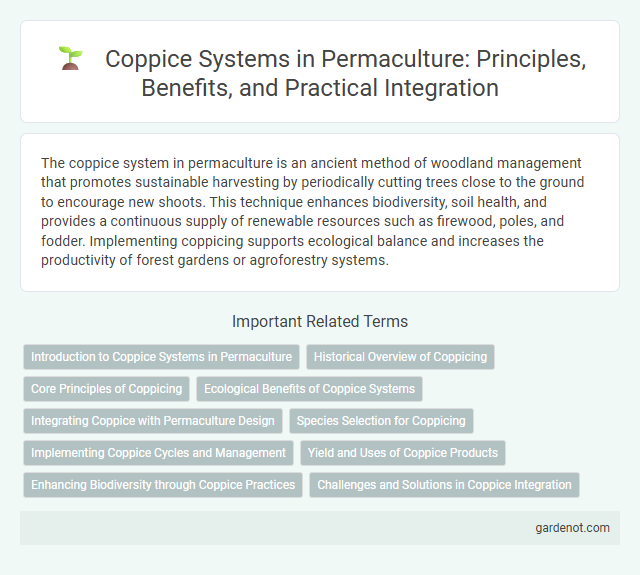The coppice system in permaculture is an ancient method of woodland management that promotes sustainable harvesting by periodically cutting trees close to the ground to encourage new shoots. This technique enhances biodiversity, soil health, and provides a continuous supply of renewable resources such as firewood, poles, and fodder. Implementing coppicing supports ecological balance and increases the productivity of forest gardens or agroforestry systems.
Introduction to Coppice Systems in Permaculture
Coppice systems in permaculture involve the strategic cutting back of trees and shrubs to stimulate new growth, creating a sustainable source of wood and biomass. This technique enhances soil fertility, promotes biodiversity, and provides renewable materials for fuel, fencing, and craft. Implementing coppicing supports carbon sequestration and ecosystem resilience by maintaining continuous plant cover and reducing deforestation pressure.
Historical Overview of Coppicing
Coppicing is an ancient woodland management technique dating back over 8,000 years, essential in European and Asian permaculture traditions. Archaeological evidence from Neolithic settlements reveals systematic tree cutting to promote regrowth for sustainable timber and fuel. This historical practice laid the foundation for renewable resource management, influencing modern permaculture principles focused on biodiversity and ecosystem resilience.
Core Principles of Coppicing
Coppicing involves the cyclical cutting of trees at the base to promote vigorous regrowth, harnessing the natural ability of many species to regenerate from stumps or roots. This core principle supports sustainable wood production by maintaining continuous canopy cover and enhancing biodiversity within permaculture systems. By mimicking natural disturbance patterns, coppicing balances resource extraction with ecological resilience and soil preservation.
Ecological Benefits of Coppice Systems
Coppice systems enhance biodiversity by creating diverse habitats through cyclical cutting and regrowth, supporting a wide range of flora and fauna. These systems improve soil health by increasing organic matter and preventing erosion, promoting nutrient cycling and water retention. Carbon sequestration in coppiced woodlands mitigates climate change effects, making them vital for sustainable land management.
Integrating Coppice with Permaculture Design
Integrating coppice systems into permaculture design enhances sustainable wood production by promoting rapid regrowth through periodic cutting of multi-stemmed trees. This practice supports biodiversity by providing habitat diversity and contributes to soil health through organic matter recycling. Strategic placement of coppice within permaculture zones optimizes resource use and maintains ecosystem balance.
Species Selection for Coppicing
Selecting appropriate species for a coppice system involves choosing fast-growing hardwoods like willow, chestnut, and hazel, known for their vigorous regrowth after cutting. These species exhibit strong regenerative capabilities, ensuring sustainable wood production and soil conservation. Incorporating nitrogen-fixing plants alongside coppice trees enhances soil fertility, promoting long-term ecosystem health in permaculture designs.
Implementing Coppice Cycles and Management
Implementing coppice cycles involves cutting trees or shrubs close to the ground to encourage new shoots for sustainable harvesting in permaculture. Proper management requires monitoring growth stages, ensuring optimal rotation periods between cuts to maintain soil health and biodiversity. Integrating coppice systems with agroforestry enhances nutrient cycling and supports resilient, productive ecosystems.
Yield and Uses of Coppice Products
Coppice systems provide high-yield biomass by promoting rapid regrowth from tree stumps, with harvests occurring every 3 to 7 years depending on species. Coppiced wood serves diverse uses including fuelwood, fencing, charcoal production, and artisan crafts, contributing to sustainable resource management. This cyclical harvesting method supports soil health while supplying renewable raw materials for energy and construction.
Enhancing Biodiversity through Coppice Practices
Coppice practices in permaculture significantly enhance biodiversity by creating diverse habitat structures that support various plant and animal species. Regular cutting cycles stimulate vigorous regrowth and increase nutrient cycling, promoting soil health and ecosystem resilience. This dynamic growth pattern fosters a mosaic of age classes and vegetation densities, crucial for sustaining rich wildlife communities and ecological balance.
Challenges and Solutions in Coppice Integration
Coppice systems often face challenges such as slow initial growth rates, pest infestations, and soil nutrient depletion, which can hinder sustainable yields. Implementing integrated pest management, selecting fast-growing native species, and practicing soil enrichment through organic mulching and crop rotation significantly enhance coppice productivity. Utilizing mixed-species plantations and regular monitoring supports resilience against environmental stresses and improves long-term ecosystem health.
Coppice system Infographic

 gardenot.com
gardenot.com